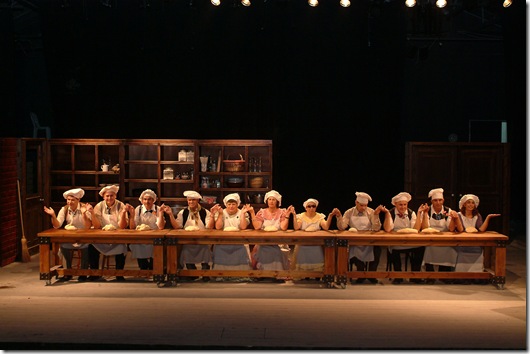Not by Bread Alone: The Nagala’at Acting Ensemble Company, World’s only Professional Deaf-Blind Theatre Company at ArtsEmerson
Photo: Avshalow Ahraron.
Not by Bread Alone may be the most unusual theatre experience I have ever undergone. It is a devised piece created by the professional director Adina Tal and the blind and deaf members of the Israeli Nalaga’at Acting Ensemble Company, none of whom had ever appeared onstage before undertaking Light Is Heard in Zig Zag, first performed in 2004 after two years of rehearsal. The Nalaga’ at, whose name means Do Touch, is the world’s only professional deaf-blind acting troupe.
Light Is Heard in Zig Zag, attempted to bring the spectators into the performers’ world, i.e., a world of only three senses. The company’s talent and the work’s uniqueness made it a success that prompted the group to develop their second production, Not by Bread Alone. The eleven performers and their director built on the techniques they had acquired during their first undertaking.
Bread and all it means symbolically, psychologically, and physically is the play’s frame. Not by Bread Alone begins in a large kitchen with all but one of the actors, wearing bakers’ hats and aprons at a long table facing the audience, efficiently and deeply concentrated on kneading dough. Down left Itzik, the company intellectual and poet, is using a braille typewriter. As he types, music is heard, giving the impression that he is playing an instrument. Observing the breadmakers closely, you note that their concentration is in their hands. When the kneading is complete, black clothed interpreters carefully carry the dough to the ovens where it bakes throughout the running time, filling the theatre with its delicious fragrance. It is a strikingly original way of allowing the audience to appreciate the joy that can exist even in a life of limitation. Likely, the aroma of the baking bread, which grows more intense over the show makes the theatregoers more aware of their sense of smell than they were upon entering the theatre.
A drum is struck and the stage goes black, a device used throughout to divide scenes. As the lights come up, all the actors’ faces are covered with white masks. Does this signify that they are blanks to us? As they tell their stories, they remove their masks, thus revealing their individuality.
The play’s structure is a series of sketches, monologues – some partially or even fully spoken – most conveyed through sign language. When a pair of actors signs, each must touch the other’s hand to achieve mutual understanding. Thus, simultaneous conversation cannot take place between more than two people. Much needed English supertitles appear on a screen above the stage.
Many of the cast suffer from Usher’s syndrome, a genetic disease that destroys hearing and sight. Some children with the malady are born deaf; for others it is progressive. Some sufferers do not start to lose their sight – which may take years – until pre-puberty. The degree of the illness affects the skills the actors can manifest. Thus, actors and interpreters may collaborate more or less closely depending on how much the performer needs the interpreter’s aid.
The actors’ stories involve their dreams, ambitions, and occasionally fears. Itzik describes being alone in his room during a rain storm he cannot hear. Suddenly, the dark soundless world he inhabits becomes more salient, his solitude nightmarish. After the storm, he goes out and meets some friends and life feels good again. As a girl Bat-Sheva dreamed of being a model, an actress, a glamorous figure on magazine covers. Now, a mature woman, her fantasy has shrunk to having her hair styled by Israel’s most celebrated hairdresser. She has a lot of charm, grace, and a very expressive face. The capacity of a number of actors to reveal feeling facially was surprising. Two brothers Igor and Yuri, along with Mark, perform short comic bits reminiscent of Charlie Chaplin and Buster Keaton silent films. Another scene involves the entire cast on tour in a fantastical Rome.
The show ends on a joyous note: a wedding, complete with a chuppah, bridal ring, and the breaking of the wine glass, in this case, a paper cup to prevent an accident. That the wedding takes place between the plump middle-aged Zipora Malca and the considerably younger, attractive Yuri Osherov adds a humorous touch. In lieu of a wedding feast, the bread is served and the audience invited to share it with the performers and interpreters onstage.
While I found the show thoroughly enjoyable, I wonder about the company’s future. The style and material are interesting, but it is difficult to see how much change and variety the director and actors will be able to bring to prospective material. Their productions are years in the making in large part because of communication difficulties. Does their present success result from their uniqueness? What are their long term goals?
ArtsEmerson presents Nalaga’at Deaf-Blind Theatre at the Paramount Theatre, Boston, MA
Created by Adina Tal and the Nalaga’at Deaf-Blind Theatre Ensemble
Conceived and Directed By Adina Tal
Set Design: Eithan Ronel
Costume Design: Ori Rubenstein
Cast
Evgenia Shtesky, Shoshana Segal, Igor Osherov, Zipora Malca, Bat-Sheva Rabansari, Yuri Osherov, Mark Yaroski, Itshak Hanina, Yuriy Tverdovsky, Rafaek Akoa
